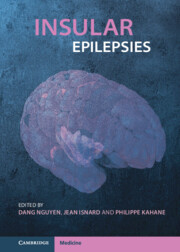Book contents
- Insular Epilepsies
- Insular Epilepsies
- Copyright page
- Contents
- Contributors
- Foreword
- Chapter 1 A Brief History of Insular Cortex Epilepsy
- Section 1 The Human Insula from an Epileptological Standpoint
- Chapter 2 Anatomy of the Insula
- Chapter 3 Vascularization of the Insula: Key Points for Safe Epilepsy Surgery
- Chapter 4 Structural Connectivity of the Insula
- Chapter 5 Functional Connectivity of the Insula
- Chapter 6 Interoceptive Integration in the Primate Insular Cortex
- Section 2 The Spectrum of Epilepsies Involving the Insula
- Section 3 Noninvasive Investigation of Insular Epilepsy
- Section 4 Invasive Investigation of Insular Epilepsy
- Section 5 Surgical Management of Insular Epilepsy
- Index
- References
Chapter 4 - Structural Connectivity of the Insula
from Section 1 - The Human Insula from an Epileptological Standpoint
Published online by Cambridge University Press: 09 June 2022
- Insular Epilepsies
- Insular Epilepsies
- Copyright page
- Contents
- Contributors
- Foreword
- Chapter 1 A Brief History of Insular Cortex Epilepsy
- Section 1 The Human Insula from an Epileptological Standpoint
- Chapter 2 Anatomy of the Insula
- Chapter 3 Vascularization of the Insula: Key Points for Safe Epilepsy Surgery
- Chapter 4 Structural Connectivity of the Insula
- Chapter 5 Functional Connectivity of the Insula
- Chapter 6 Interoceptive Integration in the Primate Insular Cortex
- Section 2 The Spectrum of Epilepsies Involving the Insula
- Section 3 Noninvasive Investigation of Insular Epilepsy
- Section 4 Invasive Investigation of Insular Epilepsy
- Section 5 Surgical Management of Insular Epilepsy
- Index
- References
Summary
The insular cortex is an extensively connected brain region that has recently gained considerable interest due to its elusive role in several pathological conditions and its involvement in a variety of functions. Structural connectivity studies have identified connections to the frontal, temporal, and parietal cortices, with both a rostro-caudal and a dorso-ventral organizational pattern. The insula is also widely connected to subcortical structures. The use of diffusion-weighted imaging in insular epilepsy has not yet reached its full potential; however, it may still provide some insights into its pathophysiology, assess long-term consequences, and help prevent operative complications. This chapter explores the insula’s structural connectivity and promising applications in the field of insular epilepsy.
Keywords
- Type
- Chapter
- Information
- Insular Epilepsies , pp. 31 - 39Publisher: Cambridge University PressPrint publication year: 2022
References
- 1
- Cited by

